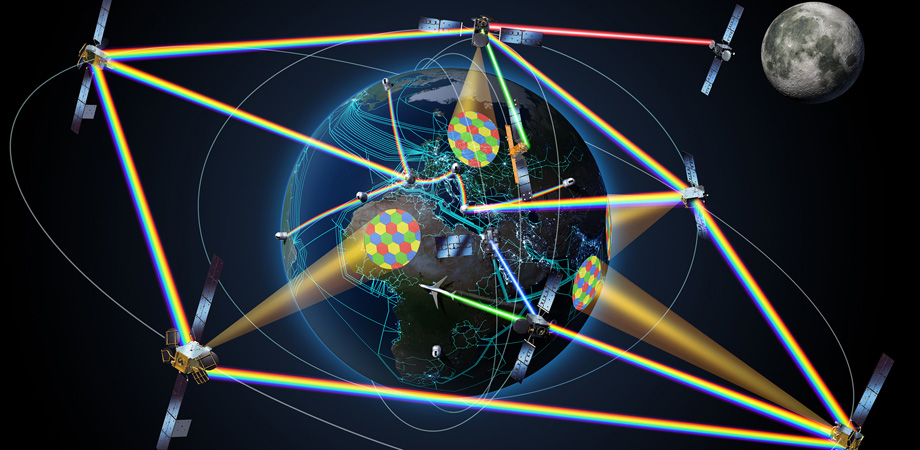What is Free Space Optics Communication?
Free space optics (FSO) communication, also known as optical wireless, is a line-of-sight method for transmitting data from one location to another using visible and infrared light. In FSO communication, data is encoded onto beams of light and transmitted through the atmosphere. On the receiving end, a photodetector located in an optical receiver decodes the light signal to recover the original data.
How Does FSO Communication Work?
In an FSO system, a semiconductor laser diode or light-emitting diode at the transmitter location is modulated with data. The modulated light beam is directed by a transmitter optical assembly, which includes a lens or reflector, to collimate or focus the beam over the free space channel. At the receiver location, a telescope with a photodetector receives the optical signal and converts it back into an electrical signal. The data is then processed for transmission over a local area network or wide area network. FSO systems operate in a point-to-point configuration, requiring line-of-sight between the transmitter and receiver.
Advantages of FSO Over Wired Connections
One major advantage of Free Space Optics Communication over wired connections like fiber optic cables is faster deployment times. While laying cable infrastructure can take months or even years of planning and construction, FSO systems can be set up in a matter of hours or days. This makes FSO an attractive option for temporary deployments or rapid response situations. FSO links are also more flexible and reconfigurable compared to fixed fiber routes.
Another advantage is lower upfront costs. FSO equipment has gotten smaller, simpler, and more affordable in recent years. This has made outdoor deployments viable even for smaller applications that may not justify the expense of buried or aerial fiber. FSO links also avoid expensive trenching, permitting, right of way issues and other complications associated with laying new wired networks.
Obstacles of Free Space Optical Communication
While promising for many applications, Free Space Optics Communication do face some challenges that limit their real-world deployment. Line-of-sight transmission requires an unobstructed path between the transmitter and receiver, meaning objects like trees, buildings or fog can block the beam. Weather conditions such as rain, snow and fog can attenuate or scatter the optical signal, making reliable communication difficult. Fine particulate matter in the atmosphere also impacts performance.
Turbulence in the air along the propagation path causes optical beams to wander, spreading and reducing power density at the receiver. Maintaining proper alignment between transceivers under these dynamic conditions requires sophisticated tracking systems. Thermal blooming, where the refractive index of air fluctuates due to heating and cooling, also distorts beams. These phenomena collectively limit maximum link ranges typically to a few kilometers depending on wavelength and environmental factors.
Addressing Obstacles with New Technologies
Developers are pursuing a variety of techniques to overcome the limitations of atmospheric propagation for FSO. Wavelength diversity switches between different wavelengths that experience less attenuation in changing conditions. Adaptive optics and beacons enable dynamic compensation of beam wandering. More sophisticated tracking, acquisition and pointing technologies maintain alignment even during high turbulence events.
Use of multiple apertures with advanced combining techniques provide resilience against shadowing and scattering. Complementing optical links with lower-data rate radio systems maintains connectivity under adverse weather. Researchers are also exploring integrating FSO with advanced networking architectures like free-space optical mesh networks to extend coverage.
These innovations coupled with continued miniaturization and cost reductions could expand viable deployments for FSO to serve as wireless fiber for distributed applications like 5G cellular networks, backhaul for remote sensors and inter-vehicle communication. With careful engineering, the technology may help deliver multi-gigabit connectivity practically anywhere and facilitate new services not possible with traditional infrastructure alone.
Growing Markets for FSO Communication
The global market for FSO communication has been growing steadily as capabilities advance and costs decline. According to recent studies, the overall FSO market is projected to reach over $3 billion by 2030 from around $1 billion in 2020. Major segments driving this growth include cable offload, space applications, disaster recovery networks, wireless fiber extensions for cellular networks and connectivity to stationary and mobile platforms at sea and in the air.
Municipal networks, smart city projects, data center interconnects and enterprise solutions within business campuses have emerged as key near-term commercial opportunities. Government and defense agencies also see value in rapidly deployable secure backbone networks as complements or alternatives to satellites. Overall, the versatile point-to-point wireless capabilities of FSO communication continue making it an appealing niche technology for situations where other options are unavailable, unsuitable or too costly. With further technical and economic optimization, free space optics may increasingly take on roles traditionally served by RF and fiber.
*Note:
1. Source: Coherent Market Insights, Public sources, Desk research
2. We have leveraged AI tools to mine information and compile it



